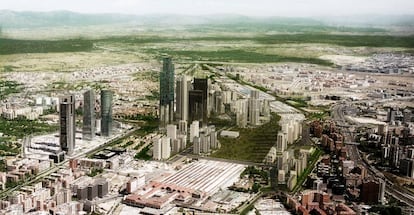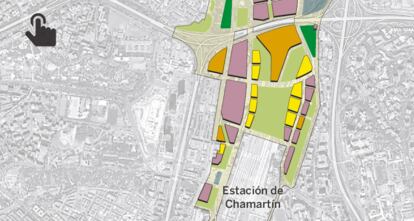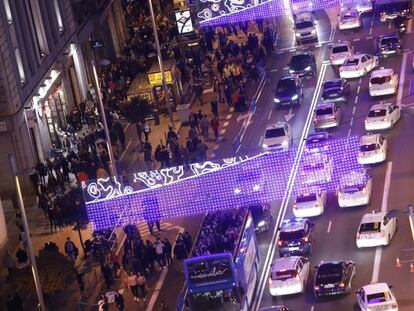Madrid to get the tallest skyscrapers in Spain
The facelift to the capital’s north is set to be the most important project for the city in the next 25 years

The facelift to the top of the Castellana, previously known as Operation Chamartín, is one of Europe’s biggest urban development schemes. But it is also one of its slowest. While Paris overhauled La Défense and London gentrified King’s Cross, Madrid’s authorities, constructors, politicians, local residents and lawmakers argued and talked and argued some more.
Now Madrid’s Mayor Manuela Carmena is carrying the project forward having brought together the warring factions under a banner of consensus and belief in the “common good.” Finally, for the first time in 25 years, it looks as though something is going to happen.

“Now the project can actually be touched and seen,” Antonio Béjar, the president of the developer Distrito Castellana Norte, said the day the project was relaunched in the presence of Carmena and the ruling Socialist Party (PSOE)’s Public Works Minister José Luis Ábalos. A huge 3D model measuring four meters by two meters was unveiled, representing what city planning chief José Manuel Calvo calls “the most important project for Madrid for the next 20 to 25 years.”
Madrid New North as the project is now known, encompasses four different areas of development, which can be split into two. On the one hand, there is the station and the new financial quarter and offices; and on the other, there are two residential zones to the north of the M30 ring road. Dividing these two will be a green corridor and a vast park that will cover the train tracks at Chamartín station, which is also due to be revamped.
Rooftop gardens
Many of the new buildings will boast rooftop gardens, including the three new skyscrapers, the highest of which will be 250 meters, making it the highest building in Spain and one of the highest in Europe. The project also aims to overhaul the existing business park, which has done nothing to improve the capital's chances of attracting international business.
Helping to boost the Ministry of Development’s coffers, the state-owned high-speed train line company Adif will raise €1.2 billion from the sale of land. Ábalos has promised to invest this money directly into the station VAT free because of its obvious benefits to the city, whose charms are to be safeguarded.
Now all that is left is to tie up a few loose ends before work begins toward the end of 2019 and the start of 2020 when an army of cranes will begin to swing into action.
The idea behind the project is to encourage homogeneous growth across the urban landscape, including its public transport and other services. There will, for example, be six new schools, three health centers and six sports centers. These facilities will not only serve the new residential zones but also the existing residential areas that have long been lacking in infrastructure. The two new residential areas to be built between the M30 and the M40 will be connected by the adjoining neighborhoods. This will mean a significant number of new properties on the market, 20% of which will be set aside as protected housing.
Private financing of the project will amount to €600 million, which will not only be spent on the homes and offices but also on a 15-kilometer bicycle lane, three new metro stations and one commuter train station.
It may seem like a vast amount of construction but it is in fact considerably less than what was envisioned during the era of former mayor Ana Botella. The green zones have been expanded and protected housing factored in, amounting to 2,200 properties, which could rise to 4,000 if the authorities also turn public land over to it.
Meanwhile, the developers hope to take advantage of the capital’s appeal to sell or rent their new offices and make the most of a development that from a strategic point of view has few competitors.
The target area will be 2,600 square kilometers, within which Agustín de Foxá street will be turned into the main boulevard, containing a mix of shops, offices and homes. The park covering Chamartín’s train tracks will be the lungs of north Madrid and will be lined with homes while three skyscrapers will redefine Madrid’s skyline.
Though the project has taken many of its cues from Paris, where the business park in La Défense was redesigned and the residential appeal of a relatively central zone improved, there are also parallels with Amsterdam, namely the important role of the train station. Amsterdam’s new neighborhood, Zuida, also know as the new ‘financial mile’, has invested €1.39 billion in 9,000 homes as well as numerous restaurants and services and, of course, a busy train station, in the hope of attracting as many as 450 new businesses to the area.

Airport access
The proximity of the Madrid-Barajas airport is, of course, an added bonus for the new development’s prospects while rail travel to northern Spain will also be expanded and the number of high-speed train tracks doubled. The actual redesign of the station will be carried out by the winners of an international competition, according to Ábalos, and will perhaps include a piano in the main hall, as Carmena has proposed.
Operation Chamartín, now rechristened Madrid New North, was first conceived of while socialist Felipe González was prime minister. It was, however, blocked by the owners of the expropriated land.
In 2013, Madrid’s City Hall revived the project under right-wing mayor Ana Botella, whose vision Carmena considered to be speculative urban development. Consequently, the current mayor reduced the scale of the construction and, after reaching an agreement with the developers, managed to get the go-ahead from the right-wing regional government. The design has also found favor with the new Public Works Minister José Luis Ábalos. At the end of this year, it is expected to gain the approval of city council and be ratified by Ángel Garrido’s regional government this spring.
English version by Heather Galloway.
Tu suscripción se está usando en otro dispositivo
¿Quieres añadir otro usuario a tu suscripción?
Si continúas leyendo en este dispositivo, no se podrá leer en el otro.
FlechaTu suscripción se está usando en otro dispositivo y solo puedes acceder a EL PAÍS desde un dispositivo a la vez.
Si quieres compartir tu cuenta, cambia tu suscripción a la modalidad Premium, así podrás añadir otro usuario. Cada uno accederá con su propia cuenta de email, lo que os permitirá personalizar vuestra experiencia en EL PAÍS.
¿Tienes una suscripción de empresa? Accede aquí para contratar más cuentas.
En el caso de no saber quién está usando tu cuenta, te recomendamos cambiar tu contraseña aquí.
Si decides continuar compartiendo tu cuenta, este mensaje se mostrará en tu dispositivo y en el de la otra persona que está usando tu cuenta de forma indefinida, afectando a tu experiencia de lectura. Puedes consultar aquí los términos y condiciones de la suscripción digital.










































